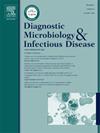Clinical and cost implications of Biofire FilmArray® meningitis / encephalitis panel testing: a systematic review
IF 2.1
4区 医学
Q3 INFECTIOUS DISEASES
Diagnostic microbiology and infectious disease
Pub Date : 2025-03-22
DOI:10.1016/j.diagmicrobio.2025.116823
引用次数: 0
Abstract
Background
Meningitis and encephalitis are diseases with high case fatality rates and serious long-term sequalae. A significant percentage do not receive an aetiological diagnosis, in part due to limitations of conventional testing methods. The Biofire FilmArray® Meningitis / Encephalitis Panel (MEP) is the first commercially approved multiplex PCR panel for diagnosis of infectious meningoencephalitis. It provides rapid results and has the potential to reduce empiric antimicrobial use and length of hospitalisation when compared to conventional testing.
Methods
We conducted a systematic review to evaluate the impact of MEP implementation by searching the Medline and Embase databases. The outcomes of interest were duration of acyclovir treatment, duration of antimicrobials, length of stay and healthcare cost.
Results
A total of 23 studies satisfied the inclusion criteria, the majority of which were retrospective studies comparing cohorts before and after MEP implementation. The included studies were very heterogenous, with variation in MEP implementation strategies, standard of care diagnostics and study populations. MEP testing resulted in reduction in acyclovir use in 75 % of studies with an average reduction of 39 h (range 11-144 h). Antimicrobial use and length of stay was reduced in 44 % and 40 % of studies respectively. Five studies looked at healthcare costs, variably described between studies as hospitalisation, antimicrobial and microbiology costs. Total hospitalisation cost was reduced in 1 study and unchanged in 2 studies.
Conclusion
Whilst MEP implementation reduces acyclovir usage in patients evaluated for ME, the benefits in terms of antibiotic use, and length of stay are variable and likely depend on the study population, implementation strategy and standard of care testing available in each institution.
Biofire FilmArray®脑膜炎/脑炎面板检测的临床和成本影响:一项系统综述
背景:脑膜炎和脑炎是病死率高、长期后遗症严重的疾病。很大比例的患者没有得到病原学诊断,部分原因是由于传统检测方法的局限性。Biofire FilmArray®脑膜炎/脑炎检测试剂盒(MEP)是首个经商业批准的用于传染性脑膜脑炎诊断的多重PCR检测试剂盒。与传统检测相比,它提供快速结果,并有可能减少经验性抗菌药物使用和住院时间。方法通过检索Medline和Embase数据库,对MEP实施的影响进行系统评价。关注的结果是阿昔洛韦治疗的持续时间、抗微生物药物的持续时间、住院时间和医疗费用。结果共有23项研究符合纳入标准,其中大多数是回顾性研究,比较了MEP实施前后的队列。纳入的研究非常异质性,在MEP实施策略、护理诊断标准和研究人群方面存在差异。MEP测试结果显示,75%的研究减少了阿昔洛韦的使用,平均减少了39小时(范围11-144小时)。抗菌药物的使用和住院时间分别减少了44%和40%。五项研究考察了医疗成本,在不同的研究中被描述为住院、抗微生物和微生物成本。总住院费用在1项研究中降低,在2项研究中保持不变。结论:虽然MEP的实施减少了ME患者的阿昔洛韦使用,但在抗生素使用和住院时间方面的益处是可变的,可能取决于每个机构的研究人群、实施策略和护理测试标准。
本文章由计算机程序翻译,如有差异,请以英文原文为准。
求助全文
约1分钟内获得全文
求助全文
来源期刊
CiteScore
5.30
自引率
3.40%
发文量
149
审稿时长
56 days
期刊介绍:
Diagnostic Microbiology and Infectious Disease keeps you informed of the latest developments in clinical microbiology and the diagnosis and treatment of infectious diseases. Packed with rigorously peer-reviewed articles and studies in bacteriology, immunology, immunoserology, infectious diseases, mycology, parasitology, and virology, the journal examines new procedures, unusual cases, controversial issues, and important new literature. Diagnostic Microbiology and Infectious Disease distinguished independent editorial board, consisting of experts from many medical specialties, ensures you extensive and authoritative coverage.

 求助内容:
求助内容: 应助结果提醒方式:
应助结果提醒方式:


